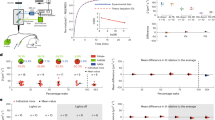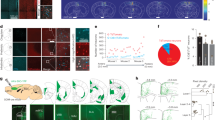Abstract
Metoclopramide is a dopamine receptor antagonist used in animals as both an antiemetic and a gastroprokinetic agent. In chickens, the drug causes central nervous system depression. The authors examined the potential sedative and hypnotic effects of metoclopramide when administered in combination with the anesthetic agent ketamine in 1–3-week-old chicks. Concomitant administration of metoclopramide and ketamine markedly reduced the median effective doses (ED50s) of both drugs for the induction of sedation and sleep in the chicks. The results suggest potential therapeutic applications of the metoclopramide-ketamine combination as a restraining agent in avian species not intended for human consumption.
This is a preview of subscription content, access via your institution
Access options
Subscribe to this journal
We are sorry, but there is no personal subscription option available for your country.
Buy this article
- Purchase on Springer Link
- Instant access to full article PDF
Prices may be subject to local taxes which are calculated during checkout

Similar content being viewed by others
References
Ahrens, F.A. Pharmacology (Williams & Wilkins, Baltimore, 1996).
Aiello, S.E. (ed.) Merck Veterinary Manual (Merck & Co., Inc., Whitehouse Station, NJ, 1998).
Kosecki, S.M. Metoclopramide: dopamine receptor antagonist, antiemetic, gastroprokinetic agent. Compend. Contin. Educ. Pract. Vet. 25(11), 826–900 (2003).
Moses, L., Harpster, N.K., Beck, K.A. & Hartzband L. Esophageal motility dysfunction in cats: a study of 44 cases. J. Am. Anim. Hosp. Assoc. 36(4), 309–312 (2000).
Coronas, R., Pitarch, L. & Mallol, J. Blockade of reserpine emesis in pigeons by metoclopramide. Europ. J. Pharmacol. 32(02), 380–382 (1975).
Fisher, A.A. & Davis, M.W. Serotonin syndrome caused by selective serotonin reuptake-inhibitors: metoclopramide interaction. Ann Pharmacother 36(1), 67–71 (2002).
Chemnitius, J.M., Haselmeyer, K.H., Gonska, B.D., Kreuzer, H. & Zech, R. Indirect parasympathomimetic activity of metoclopramide: reversible inhibition of cholinesterases from human central nervous system and blood. Pharmacol. Res. 34(1–2), 65–72 (1996).
Petroianu, G.A., Hasan, M.Y., Kosanovic, M., Vijayasarathy, C. & Saleh, A.M. Metoclopramide protection of cholinesterase from paraoxon inhibition. Vet. Hum. Toxicol. 45(5), 251–253 (2003).
Agostinucci, W.A., Gannon, R.H., Schauer, P.K. & Walter, J.K. Continuous infusion of metoclopramide for the prevention of chemotherapy-induced emesis. Clin. Pharm. 5(2), 150–153 (1986).
Qualie, J.M. & Hall, J. Study of oral high-dose metoclopramide in cytotoxic drug-induced nausea and vomiting. Pharmacol. J. 243(Suppl), PR21 (1989).
Rang, H.P., Dale, M.M., Ritter, J.M. & Moore, P.K. Pharmacology. 5th edn. (Churchill Livingstone, Edinburgh, 2003).
Al-Zubaidy, M.H.I. & Mohammad, F.K. Metoclopramide-induced central nervous system depression in chickens. BMC Vet. Res. 1(6), 1–4 (2005).
Gupta, V.K. Metoclopramide is not an analgesic: reflection on premature scientific conclusion. Int. J. Clin. Pract. 60(6), 744 (2006).
Lisander, B. Evaluation of the analgesic effect of metoclopramide after opioid-free analgesia. Br. J. Anaesth. 70(6), 631–633 (1993).
Ceyhan, A., Ustun,H., Altunatmaz, K., Ide, T. & Unal, N. Is metoclopramide an alternative to tramadol in the management of post-operative pain? An experimental study. J. Vet. Med. A Physiol. Pathol. Clin. Med. 52(5), 249–253 (2005).
Ramaswamy, S. & Bapna, S.J. Analgesic effect of metoclopramide and its mechanism. Life Sci. 38(14), 1289–1292 (1986).
Cicek, M. et al. Prospective, randomized, double blind, controlled comparison of metoclopramide and pethidine in the emergency treatment of acute primary vascular and tension type headache episodes. Emerg. Med. J. 21(3), 323–326 (2004).
Wheler, C. Avian anesthetics, analgesics, and tranquilizers. Semin. Avian. Exot. Pet. Med. 2(1), 7–12 (1993).
Institute for Laboratory Animal Research, National Research Council. Guide for the Care and Use of Laboratory Animals (National Academy Press, Washington, DC, 1996).
McGrath, C.J., Lee, J.C. & Campbell, V.L. Dose-response anesthetic effects of ketamine in the chicken. Am. Vet. Res. 45(3), 531–534 (1984).
Mohammad, F.K., Al-Badrany, M.S. & Al-Hasan, A.M. Detomidine-ketamine anaesthesia in chickens. Vet. Rec. 133(8), 192 (1993).
Dixon, W.J. Efficient analysis of experimental observations. Annu. Rev. Pharmacol. Toxicol. 20, 441–462 (1980).
Puig, M.M., Warner, W. & Pol, O. Intestinal inflammation and morphine tolerance alter the interaction between morphine and clonidine on gastrointestinal transit in mice. Anesthesiology 93(1), 219–230 (2000).
Tallarida, R.J. Statistical analysis of drug combinations for synergism. Pain. 49(1), 93–97 (1992).
Petrie, A. & Watson, P. Statistics for Veterinary and Animal Science (Blackwell Science, Oxford, 1999).
Hsu, W.H. Xylazine-induced depression and its antagonism by alpha adrenergic blocking agents. J. Pharmacol. Exp. Therap. 218(1), 188–192 (1981).
Ruskoaho, H. & Karppanen, H. Xylazine-induced sedation in chicks is inhibited by opiate receptor antagonists. Eurp. J. Pharmacol. 100(1), 91–96 (1984).
Bowman, M.R. Effect of metoclopramide on gastrointestinal motility of hispaniolan parrots birds. Proc. Annu. Meet. Am. Assoc. Zoo Vet. A44, 117 (2002).
Al-Zubaidy, M.H.I. Interaction of Metoclopramide with Cholinesterase Inhibitors in Chicks. MSc Thesis. College of Veterinary Medicine, University of Mosul, Mosul, Iraq (2004). [Arabic].
Acknowledgements
This study was supported by the College of Veterinary Medicine, University of Mosul, Iraq.
Author information
Authors and Affiliations
Corresponding author
Ethics declarations
Competing interests
The authors declare no competing financial interests.
Rights and permissions
About this article
Cite this article
Mohammad, F., Al-Zubaidy, M. & Alias, A. Sedative and hypnotic effects of combined administration of metoclopramide and ketamine in chickens. Lab Anim 36, 35–39 (2007). https://doi.org/10.1038/laban0407-35
Received:
Accepted:
Issue Date:
DOI: https://doi.org/10.1038/laban0407-35
This article is cited by
-
Effect of memantine hydrochloride on cisplatin-induced neurobehavioral toxicity in mice
Acta Neurologica Belgica (2020)
-
Hippocampal long-term potentiation in adult mice after recovery from ketamine anesthesia
Lab Animal (2014)



